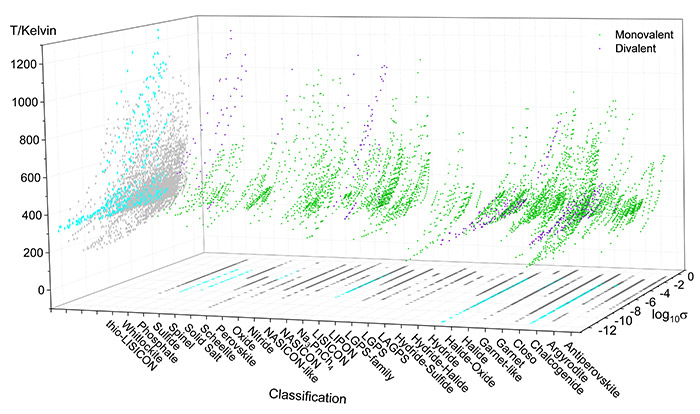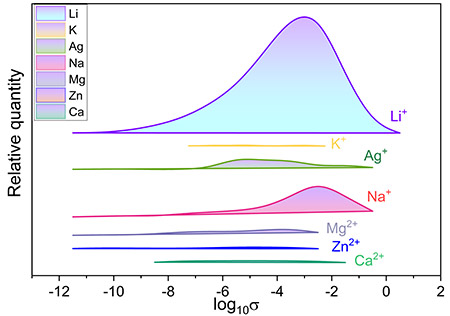

As the clean transition drives uptake of electric vehicles and energy storage for an electricity grid with ever greater dependence on variable renewable energy sources such as wind and solar, the danger from battery fires grows as well. To limit this risk while improving battery performance, the next generation of batteries is likely to depend on new solid-state electrolytes, but research has been hampered by the sheer volume of material options and the parameters involved.
Machine learning, however, is coming to the rescue. A group of materials scientists have developed a new, dynamic database of hundreds of solid-state electrolytes to which they have applied artificial intelligence techniques that are already steering research in better directions.
A paper describing their approach was published in the journal Nano Materials Science on September 10, 2023.
Organic solvents are commonly used as electrolytes—those substances, usually liquids or gels, that facilitate the movement of charged particles, or ions, between the positive and negative electrodes—in many rechargeable batteries. This type of solvents provides good conductivity and allows for the efficient transport of ions between the electrodes, but a range of safety and performance concerns means that battery researchers have long been on the hunt for alternative electrolyte materials.
In particular, organic solvents can be flammable and may lead to thermal runaway reactions, causing fires or explosions. Additionally, organic solvents can be prone to chemical decomposition, which can result in the formation of gas and the breakdown of the electrolyte over time, reducing the battery's performance and lifespan. In addition, they sometimes suffer from a limited range of voltages that the battery can operate within.
One alternative pathway has all-solid-state batteries (ASSBs), in which the traditional liquid or gel organic solvent is replaced by a solid electrolyte—eliminating the problem of leakage and thus explosion. Not only do these solid-state electrolytes improve on safety, they also deliver higher energy density, and—potentially—faster charging times.
However, the journey to finding solid state electrolytes, or SSEs, with high ionic conductivity—the ability for ions to move through the battery and produce a current—has been riddled with challenges, primarily due to their complex structures and the relationship between those structures and performance. So far, only SSEs with sluggish ion migration have been identified. Without high-performance SSEs, the development of ASSBs has been severely hampered.
“Making matters worse is the sheer number of SSEs to choose from,” said Hao Li, a materials scientist with the Advanced Institute for Materials Research at Tohoku University and the corresponding author of the paper. “There are hundreds of possibilities, and it’s a real challenge for researchers to tackle such a volume of options while keeping track of the many various parameters of optimal performance.”
So the team developed an experimental dynamic database, the Dynamic Database of Solid-State Electrolyte (DDSE), that initially contained over 600 potential solid-state electrolyte materials, spanning a wide range of operating temperatures and encompassing various cations and anions (positive and negative ions), to explore the relationships among the different variables.
Video showing how a user can use the DDSE database for solid-state electrolyte research ©Hao Li et al.
A dynamic database is a type of database that is designed to be easily updated and modified frequently, allowing for real-time changes and additions to the data it contains. This type of database is often used in situations where the information is constantly evolving. In this case, the DDSE is continuously updated with new experimental data. The database is updated weekly and as of January 2024, contained over 1000 materials.

Distribution of the materials in the DDSE database as a function of material class, ionic conductivity, and temperature. ©Hao Li et al.
The researchers then applied machine learning to the DDSE to overcome the limitations of both human analysis and the extraordinary computational expense of theoretical calculations. In the absence of machine learning, researchers have struggled to computationally wrangle the large atomic system of SSEs as well as the complexity of the chemical reactions involved.
By leveraging machine learning, researchers can make better predictions about novel solid-state electrolyte materials at much lower computational (and financial) expense, with minimum waste of time compared to previous trial-and-error attempts at SSE design.
In so doing, they have begun to tease out the intricate relationships among multiple different variables, including ion transport, composition, activation energy (the amount of energy required to kick off a chemical reaction), and conductivity, enabling the development of a new set of guidelines for the design of SSEs. The researchers have already identified the development and performance trends of SSEs across various classes of materials, as well as performance bottlenecks for each class of SSEs.
The DDSE was also designed with a user-friendly interface to enable other battery and materials scientists beyond the original team to update and use it themselves.

Performance of the cation conductivity of the SSE materials summarized based on the DDSE database. ©Hao Li et al.
| 論文タイトル: | A dynamic database of solid-state electrolyte (DDSE) picturing all-solid-state batteries |
|---|---|
| 著者: | Fangling Yang, Egon Campos dos Santos*, Xue Jia, Ryuhei Sato, Kazuaki Kisu, Yusuke Hashimoto, Shin-ichi Orimo, Hao Li* |
| 雑誌名: | Nano Materials Science |
| DOI番号: | 10.1016/j.nanoms.2023.08.002 |
東北大学材料科学高等研究所(WPI-AIMR)
Hao Li
| E-mail: | li.hao.b8@tohoku.ac.jp |
|---|---|
| Webstie: | Hao Li Laboratory |
東北大学材料科学高等研究所(WPI-AIMR) 広報戦略室
| Tel: | 022-217-6146 |
|---|---|
| E-mail: | aimr-outreach@grp.tohoku.ac.jp |